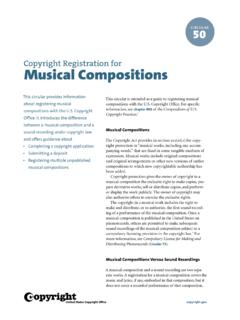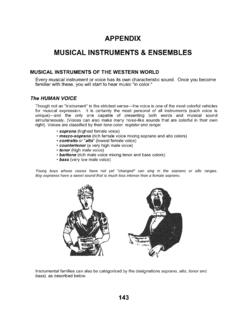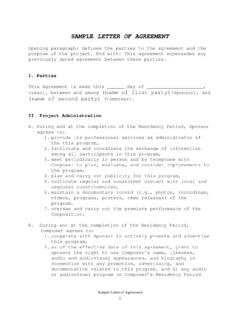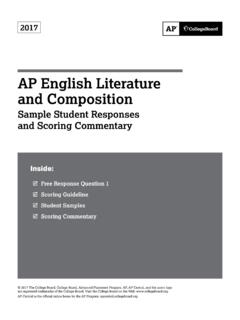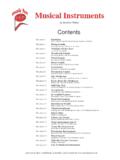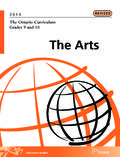Transcription of Musical Symbols - Piano Fun
1 Musical Symbols From Wikipedia, the free encyclopedia For the use of Musical Symbols on Wikipedia, see Help: Musical Symbols . Musical Symbols are the marks and Symbols , used since about the 13th century in the Musical notation of Musical scores, styles, and instruments, in order to describe pitch, rhythm, tempo and, to some degree, its articulation ( , a composition in its fundamentals). Staff The staff is the fundamental latticework of music notation, upon which Symbols are placed. The five staff lines and four intervening spaces correspond to pitches of the diatonic scale which pitch is meant by a given line or space is defined by the clef.
2 Ledger or leger lines Used to extend the staff to pitches that fall above or below it. Such ledger lines are placed behind the note heads, and extend a small distance to each side. Multiple ledger lines can be used when necessary to notate pitches even farther above or below the staff. Bar line Used to separate measures (see time signatures below for an explanation of measures). Also used for changes in time signature. Bar lines are extended to connect multiple staves in certain types of music, such as keyboard, harp, and conductor scores, but are omitted for other types of music, such as vocal scores.
3 Double bar line, Double barline Used to separate two sections of music or placed before a change in key signature. Bold double bar line, Bold double barline Used to indicate the conclusion of a movement or an entire composition. Dotted bar line, Dotted barline Subdivides long measures of complex meter into shorter segments for ease of reading, usually according to natural rhythmic subdivisions. Bracket Connects two or more lines of music that sound simultaneously. In general contemporary usage the bracket usually connects the staves of separate instruments ( , flute and clarinet; 2 trumpets; etc.)
4 Or multiple vocal parts in a choir or ensemble, whereas the brace connects multiple parts for a single instrument ( , the right-hand and left-hand staves of a Piano or harp part). Brace Connects two or more lines of music that are played simultaneously in keyboard and harp music.[1] Depending on the instruments playing, the brace, (occasionally called an "accolade" in some old texts), will vary in designs and styles. Clefs Main article: Clef Clefs define the pitch range, or tessitura, of the staff on which it is placed. A clef is usually the leftmost symbol on a staff.
5 Additional clefs may appear in the middle of a staff to indicate a change in register for instruments with a wide range. In early music, clefs could be placed on any of several lines on a staff. G clef (Treble clef) The centre of the spiral defines the line or space upon which it rests as the pitch G above middle C, or approximately 392 Hz. Positioned here, it assigns G above middle C to the second line from the bottom of the staff, and is referred to as the "treble clef." This is the most commonly encountered clef in modern notation, and is used for most modern vocal music.
6 Middle C is the first ledger line below the staff here. The shape of the clef comes from a stylised upper-case-G. C clef (Alto clef and Tenor clef) This clef points to the line (or space, rarely) representing middle C, or approximately 262 Hz. Positioned here, it makes the center line on the staff middle C, and is referred to as the "alto clef." This clef is used in modern notation for the viola. While all clefs can be placed anywhere on the staff to indicate various tessitura, the C clef is most often considered a "movable" clef: it is frequently seen pointing instead to the fourth line and called a "tenor clef".
7 This clef is used very often in music written for bassoon, cello, trombone, and double bass; it replaces the bass clef when the number of ledger lines above the bass staff hinders easy reading. C clefs were used in vocal music of the classical era and earlier; however, their usage in vocal music has been supplanted by the universal use of the treble and bass clefs. Modern editions of music from such periods generally transpose the original C clef parts to either treble (female voices), octave treble (tenors), or bass clef (tenors and basses).
8 F clef (Bass clef) The line or space between the dots in this clef denotes F below middle C, or approximately 175 Hz. Positioned here, it makes the second line from the top of the staff F below middle C, and is called a "bass clef." This clef appears nearly as often as the treble clef, especially in choral music, where it represents the bass and baritone voices. Middle C is the first ledger line above the staff here. In old music, particularly vocal scores, this clef is sometimes encountered centered on the third staff line, in which position it is referred to as a baritone clef; this usage has essentially become obsolete.
9 The shape of the clef comes from a stylised upper-case-F (which used to be written the reverse of the modern F) Neutral clef Used for pitchless instruments, such as some of those used for percussion. Each line can represent a specific percussion instrument within a set, such as in a drum set. Two different styles of neutral clefs are pictured here. It may also be drawn with a separate single-line staff for each untuned percussion instrument. Octave clef Treble and bass clefs can also be modified by octave numbers. An eight or fifteen above a clef raises the intended pitch range by one or two octaves respectively.
10 Similarly, an eight or fifteen below a clef lowers the pitch range by one or two octaves respectively. A treble clef with an eight below is the most commonly used, typically used for guitar and similar instruments. Tablature For stringed instruments it is possible to notate tablature in place of ordinary notes. In this case, a TAB sign is often written instead of a clef. The number of lines of the staff is not necessarily five: one line is used for each string of the instrument (so, for standard 6-stringed guitars, six lines would be used).
